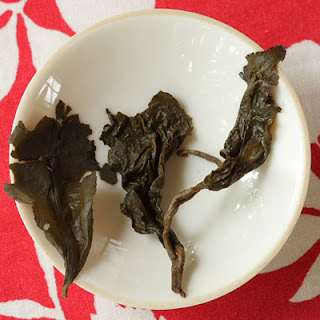 Tea: Aged Oolong from Cloudwalker Teas
Tea: Aged Oolong from Cloudwalker TeasOrigin: Taiwan
Harvest: 1988During the second part of my session with Director's Cut yesterday we tasted a tea with which I am very familiar: Cloudwalker Teas' 20 year old oolong tea. (Although the small company is physically located in Ottawa, it is run as a web-based operation with no storefront location. This may seem a barrier, but the customer service is excellent and I recommend checking them out if you have an interest in the kind of teas they have on offer. The company blog is located here.) Unfortunately, little is known to me about the origins of this tea other than it being some sort of Taiwanese oolong that's been aged for about twenty years; this tea is, however, anything but nondescript.
Upon being placed in my warmed yixing teapot the tea's most immediately obvious characteristic becomes even more apparent: its roast. Oolongs have to be re-roasted every few years as they age in order to dispell the moisture that soaks into the leaves from the air and allow the aging process to occur properly; as a result, aged oolongs are sometimes faked by simply roasting a new tea very heavily to imitate years of gentle roasting. Telltale signs of a forged aged oolong are hard, blackened leaves which don't open much over the course of a session and have an unnaturally harsh fiery nature. This is not a fake.
Upon being placed in my warmed yixing teapot the tea's most immediately obvious characteristic becomes even more apparent: its roast. Oolongs have to be re-roasted every few years as they age in order to dispell the moisture that soaks into the leaves from the air and allow the aging process to occur properly; as a result, aged oolongs are sometimes faked by simply roasting a new tea very heavily to imitate years of gentle roasting. Telltale signs of a forged aged oolong are hard, blackened leaves which don't open much over the course of a session and have an unnaturally harsh fiery nature. This is not a fake.
 |
| The real deal. |
Holding up the teapot a powerful aroma of roast with sweet undertones bids farewell to the clay and greets rather than assaults my nasal passages. My note taking lapsed at this point barely into the session as hours of sitting with this tea resurfaced with the aroma and I got a little excited.
The incredible sweetness of this tea's aroma never ceases to amaze me, even after enough sessions to noticeably season the clay of my teapot (I tried brewing a medium oxidation/roast oolong in this pot recently and the tea felt muddied by some subtle textural interference). For the first few seconds very little emerges from the aroma cup, and then all of a sudden the liquor breaks open. An intense sticky sweet perfume of caramel and candied fruit rushes all the way to the back of the sinuses and just keeps coming. This smell, which DC likened to that of candied peaches and brie heated up together in the oven, endures with such strength that it seems it will keep on forever from the seemingly empty tiny porcelain vessel before gradually receding, leaving both DC and I with a pleasant lightheadedness. At this point, however, it proves difficult to mourn the passing of this exquisite odour as its liquid counterpart beckons from the table's surface.
 |
| Why yes, I think I will. |
Even as I lengthen the infusions a little bit more than necessary the tea exhibits an uncommon absence of harsh characteristics. The tea has a feeling of roundness and of being full of depth in the mouth, one that is certainly displayed to an advantage by the teapot in which it is brewed, but gaiwan brewing in the past has proven to me that this tea has a thickness all its own. The textural fullness of this oolong is quite unlike the creamy or oily thickness of greener and fresher teas, and is one that I suspect comes quite simply from an abundance of maturity. As I drink I develop an impression of dry old timbers, like those forming the outside wall of a barn exposed to the elements for many years rather than the wet wooden notes familiar to those who drink pu'erh.
As I lift the lid in between infusions I'm always tempted to lean in and give the tea a sniff, and the odour there is one that, for me, is at once good and bad. Good because if there ever was any doubt as to the tea's age, it's now been erased. Bad because it's a sour and slightly tangy herbaceous smell that I don't particularly like, but because it doesn't appear to me in any other instance with this tea, I just take it as a sign of being the genuine article and move right along with my brewing.
During one particularly long infusion, a hint of the sweetness that was so obvious in the smell crept into the liquor itself, but as I timed the infusions more appropriately this note disappeared. It was only in the last few very lengthy infusions that the roasted taste began to give up ground to this sweetness. For the very last infusion, I simply poured more water into the teapot, replaced the lid, and walked away. Some time later I came back to my tea board, having completely forgotten about the infusion I had started some time ago, and was delighted to find that the teapot was now full of tasty tea! This last brew was surprisingly smooth and left a sweet memory lingering pleasantly in the back of my throat, a fitting end for one of my very favourite teas.



No comments:
Post a Comment